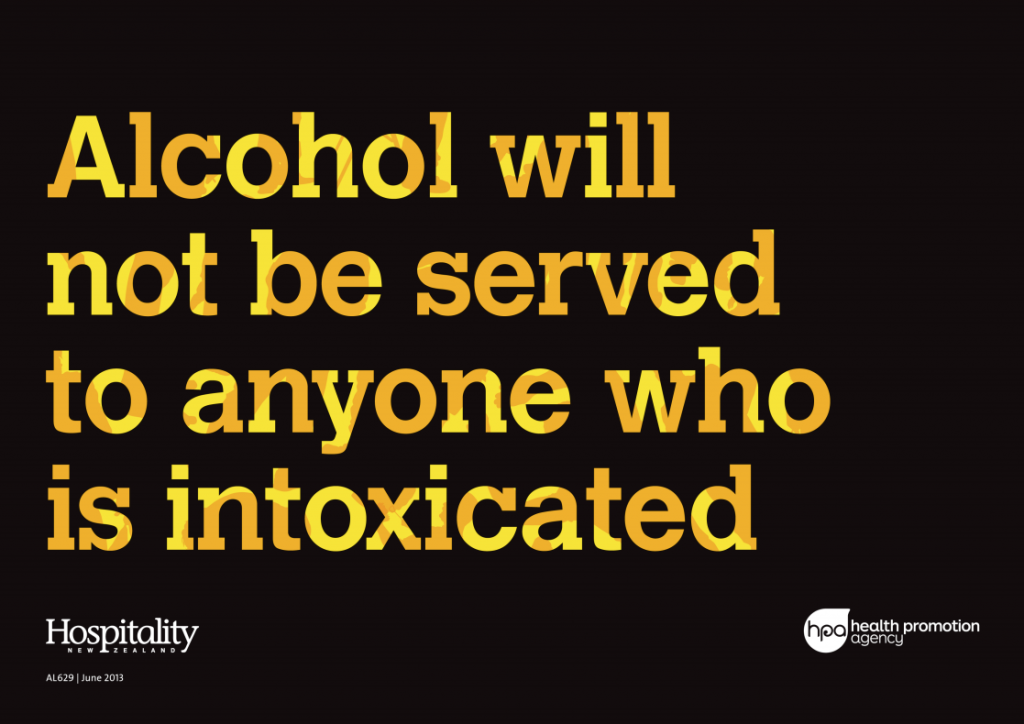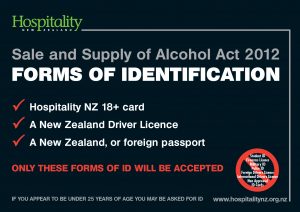マネージャー証明書
アルコール販売および供給法2012に基づく要件は、常にアルコールが販売または公衆に供給されているときは、デューティマネージャーがコンプライアンスの責任を負うことです。デューティマネージャーの証明書は、所有者がライセンスされた施設を管理することを許可します。
アプリケーションの要件
最低年齢要件は20歳です。
•ホスピタリティ、食料品、酒業界で認可された施設での6ヶ月間の経験。
• 承認されたコースプロバイダーからのライセンスコントローラーの資格。
•写真付き身分証明書(パスポート、HANZ 18+、運転免許証)。
•現在の雇用主からの参照。トレーニング、経験、および性格。
• ニュージーランド移民局が発行する就労ビザ(該当する場合)。
最初の証明書は12か月間発行され、更新証明書は3年間発行されます。
マネージャーの証明書を申請する
マネージャーの証明書を申請するには、ニュージーランド資格局の単位規格 4646 および 16705 を含むライセンスコントローラーの資格 (LCQ) が必要です。
LCQトレーニングに登録できる場所については、評議会にお問い合わせください
コースが終わったら、申請書を当社に送信できます。申請書類は評議会から取得できます。
マネージャーの証明書を申請するとどうなりますか?
すべての申請は警察とライセンス検査官に送られます。簡単なインタビューを行うために、ライセンス検査官から連絡を受けることがあります。
異議がなければ、証明書が発行されます。反対した場合、申請は公聴会で聴取され、地方議会のライセンス委員会が関与します。
発行されると、証明書は1年間有効になり、更新の申請が行われます。
マネージャーの証明書の更新
評議会に記録が登録されている管理者は、証明書の有効期限が切れる1ヶ月前までに更新申請書が送られます。これは、現在登録されている郵便番号に送信されます。更新申請の一環として、アルコール販売および供給法2012に関する知識をテストするためのアンケートが含まれています。アプリケーションの処理を開始するには、これを正しく完了する必要があります。
1989年の酒類販売法に基づくライセンスコントローラー資格(LCQ)を保有し、ブリッジングテスト証明書を修了して提供していない場合は、2012年アルコール販売および供給法に関連する単位を概説する新しいLCQコースを受講する必要があります。
更新の合間に住所が変更された場合はお知らせください。そうすれば、情報をタイムリーに受け取ることができます。
有効期限前に更新申請書が提出されていることを確認するのは、証明書所有者の責任です。更新申請が提出される前に証明書の有効期限が切れた場合、証明書は最新でなくなり、新しいマネージャーの証明書の申請を申請する必要があります。
新しい証明書は 1 年間有効です。更新時に、反対がなされなければ、証明書は3年間更新されます。
一時マネージャーまたは代理マネージャーの任命
演技マネージャー
代理マネージャーは、デューティマネージャーが病気、欠席、または一度に3週間以内、12ヶ月の期間で最大6週間の期間、または年次休暇中に任命することができます。この人がマネージャーの証明書を申請する必要はありません。予約が48時間以上になる場合は、開始日前に書面で評議会に連絡するか、以下のオンライン申請フォームに記入する必要があります。
オン、オフ、クラブライセンス
酒類販売及び供給法の2012年の目的は、酒類の販売及び供給を制限することではなく、安全で合法的な飲酒を促進することである。
アルコールを販売するには、正しいアルコールライセンスを持っていることを確認する必要があります。
ライセンス上
オンライセンスは、あなたの施設での消費のためのアルコールの販売または供給を許可します。
アルコールを販売または供給するためにオンライセンスを必要とする施設には、次のようなものがあります。
• レストラン (BYO含む)
•居酒屋、バー、パブ
• ナイトクラブ
• ホテル
• 映画館または劇場
• ファンクションセンター
•ボート、バス、飛行機、電車などの輸送。
アルコールは施設から取り除かないでください。
オフライセンス
オフライセンスにより、保有者は認可された施設外で使用するためにアルコールを販売または供給することができます。
アルコールを販売または供給するためにオンライセンスを必要とする施設には、次のようなものがあります。
• スーパーマーケット
• ボトルストア
• 食料品店
• 販売施設の削除 (オンライン注文)
• 醸造所
•ワイナリー。
酒類の販売及び供給法2012では、酪農所、ガソリンスタンド、コンビニエンスストアではアルコールを販売しないことがある。
スーパーマーケットや食料品店はビールとワインを一般に販売することしかできません。
アルコールは敷地内から摂取する必要があります。
クラブライセンス
クラブライセンスは、クラブが敷地内でのアルコールを次のものに対して販売または供給することを許可します。
• メンバー
• ゲストがメンバーに同行する
•相互訪問権を保持している他のクラブのメンバー。
クラブライセンスの保有者は、アルコールの販売および供給のために施設が開かれている間、クラブが販売または供給していないアルコールが消費されないことを保証する必要があります。
クラブライセンスの保有者は、クラブの任命された秘書がいることを常に確保するために、すべての実用的な措置を講じなければなりません。長官の変更は、任命後10日以内に当社のライセンス検査官に通知する必要があります。
アルコールの販売による利益はクラブに属していなければなりません。
申し込み方法
評議会には、記入できる申請書があります。最適なスイートの申請を取得するには、評議会に電話し、ライセンス部門に問い合わせてください。
手数料の計算
アルコールライセンス料は政府によって国家レベルで設定されています。
注意すべき重要な詳細は次のとおりです。
• 年会費は、前提ライセンスの記念日に支払われます。
• 施設のライセンスは、アルコールライセンス料に対するコスト/リスクベースのアプローチに基づいています。
以下の表を使用して施設の加重量を計算し、それを使用して施設が適合するリスクカテゴリを特定してください。計算したら、アルコールライセンス料を参照してください。
定義
クラス1のレストラン- 重要な独立したバーエリアを持つレストラン。関連するTAの意見では、バーエリアにあるテーブルに食事なしでアルコールを提供するなど、居酒屋の性質上、少なくとも一晩そのバーを運営しています。
クラス2のレストラン- 別のバー(小さなバーエリアを含む場合もある)があるが、関連するTAの意見では、いつでも酒場の性質でそのエリアを運営していないレストラン。
クラス3のレストラン- アルコールのみを食卓に提供し、独立したバーエリアを持たないレストラン。
クラス1クラブ- TAの意見では、大規模なクラブ(購入年齢1,000人以上のメンバー)であり、関連するTAの意見では、居酒屋の性質で運営されているクラブ(例えば、大規模な働く男子クラブ、複合クラブ、または大規模な「コッシー」クラブ)。
クラス2クラブ- クラス1またはクラス3の定義に適合しないクラブ(例えば、より大きなスポーツクラブ、中規模のRSA、多くの地方の社交クラブ)。
クラス3クラブ- TAによると、小規模なクラブ(購入年齢が250人未満)で、週40時間以下のバーを運営しているクラブ(ボウリングクラブ、ゴルフクラブ、ブリッジクラブ、小規模RSAなどの小規模スポーツクラブ)。
執行 — 法第28条の「保持」と同じ意味を持ちます。または、2013年12月18日以前に違反が発生した場合は、保留が発行された可能性のある以前の犯罪と同じ意味を持ちます。
手数料カテゴリ
ライセンスシステムには 5 つの手数料カテゴリがあり、コスト/リスク評価の範囲を反映しています。
[table id=10/hongi_shortcode_end>2019年7月1日から2020年6月30日まで、2019/20年の料金および料金が適用されます。記載されている場合を除き、すべての手数料と料金にはGSTが含まれています。
[table id=11/hongi_shortcode_end>アルコール施設表示看板
以下の看板は、すべてのライセンス施設に表示する必要があります。




















































